How to understand that it is time to clean the “washing machine”
If the washing machine is serviced regularly and correctly, then signs of malfunction are rare. But they can appear at any time and indicate serious blockages that need to be eliminated immediately. Common “symptoms” indicating the need for cleaning are:
- most items are harder to wash (traces of dirt remain);
- there is a persistent unpleasant odor coming from the washing machine;
- the appliance makes unusual sounds during the wash cycle;
- mold has formed on the rubber cuff (elastic band) or tray;
- limescale is present on the inner surface of the drum;
- the consumption of detergents has increased during standard washing;
- the tank is not completely filled with water;
- water leaks occur;
- the hoses are swollen or damaged.
If at least one of the above signs appears, it is necessary to clean the washing machine. This will help avoid problems with blockages, malfunctions and breakdowns.
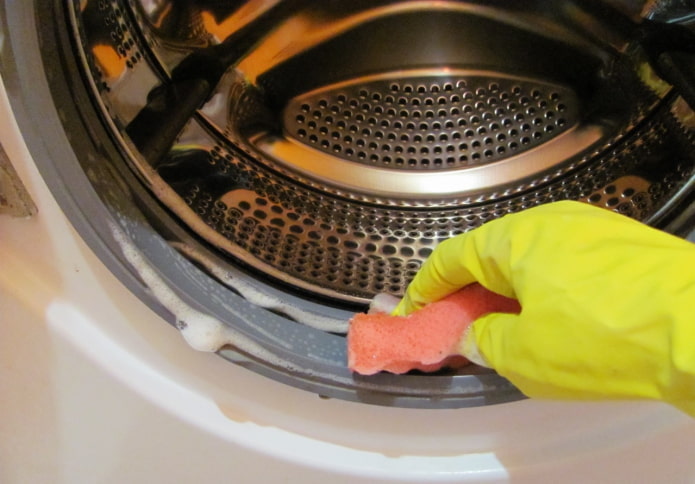
Characteristics of different types of dirt
Blockages and malfunctions are caused by different types of dirt. Most often, these are scale and accumulation of debris in the functional compartments.
- An unpleasant smell that does not disappear even after airing the machine often indicates the presence of mold (or bacteria) inside the device. This is caused by high humidity and accumulation of dirt that was not removed in a timely manner. Therefore, if your washed laundry starts to smell, immediately determine the cause of this phenomenon.
- Limescale deposits (scale) often form on metal parts of devices due to the use of hard water. As they grow, they disrupt the functionality of parts, such as a tubular electric heater. To avoid their formation, it is recommended to use water softeners and specialized chemical detergents for washing (powder or liquid compositions). If scale does appear, then it is necessary to urgently clean the washing machine.
- Often, animal hair becomes the cause of serious blockages. Special sticky wipes help reduce the risk of its accumulation in the folds of the cuff, filter and other components of the machine. Place them in the machine before washing, and they will collect most of the hairs.
- Mold not only emits an unpleasant odor, which then remains on things, but is also a source of allergic and other pathological conditions in humans. Fungal spores multiply and spread very quickly in a humid and warm environment. And if they appear, they need to be removed immediately, because the machine is in a neglected state and may soon break down.
- Dirt is the most common cause of blockages. It can have different origins, but regardless of this, it must be removed. At the first signs of its accumulation, you need to immediately clean the washing machine.
See also how to get rid of a blockage in the sink.
What is important to know for an automatic machine
An automatic machine is equipped with useful functionality that, if used correctly, helps prevent many problems, including those caused by dirt accumulation. For example, models of devices in the middle and high price segments often have a “Smart Diagnostics” and / or “Statistics Collection” mode. Their use allows you to promptly identify the risk of blockages and eliminate it.
Some models of devices are equipped with a steaming mode (program), which helps to effectively clean and thoroughly disinfect not only the laundry, but also the machine itself.
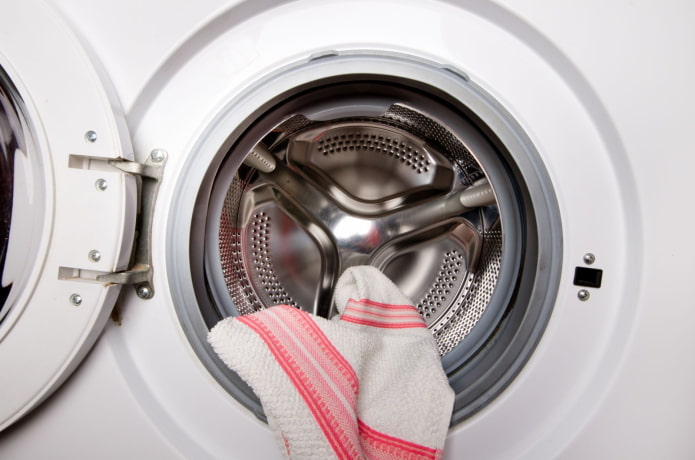
Step-by-step instructions for cleaning all parts
Each component of the device must be cleaned in accordance with the unique requirements imposed on it. Be careful and use recommended household chemicals. Then cleaning the washing machine will be effective and absolutely safe.
Cleaning the body and door of the machine
To keep the machine looking attractive and to prevent its body from wearing out quickly, it is necessary to regularly wipe it with a soft cloth or sponge. Attention should also be paid to the tank door, especially its inner side, which is constantly in contact with water and detergents (powder). Avoid using a toothbrush or any hard brush, as it will scratch the body.
Step-by-step instructions:
- Wipe the body thoroughly with a damp microfiber cloth (or any soft cloth with good moisture absorption). If there are stubborn stains, prepare a solution of water and a few drops of dishwashing gel (or use a standard soap solution). They need to wipe all dirty areas.
- Moisten a clean cloth (or soft foam sponge) with a weak solution of vinegar (citric acid is acceptable). Wipe the door on both sides, paying close attention to the inside.
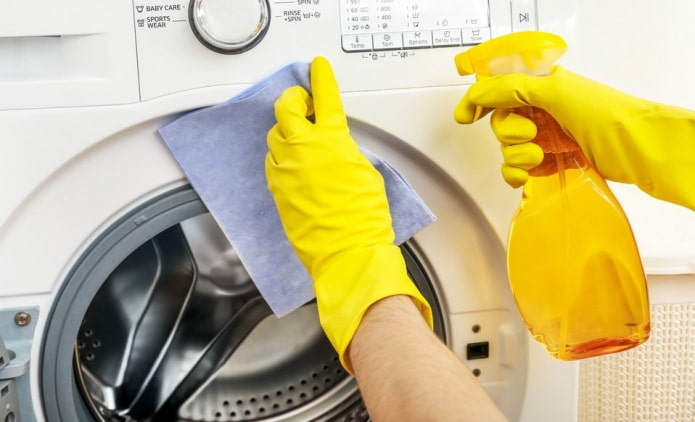
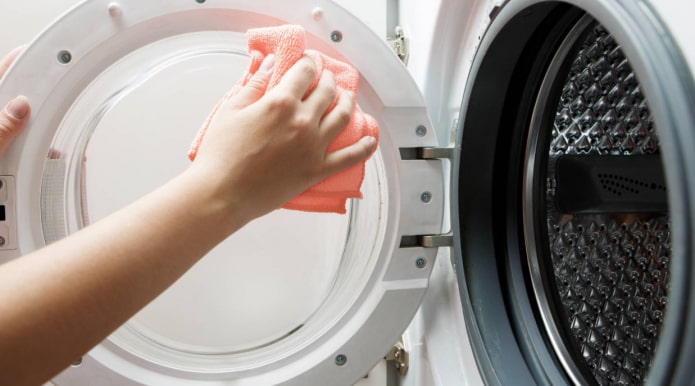
Cleaning the drum
The drum of any washing machine is also susceptible to contamination. Limescale, mold or bacteria, etc. can form on its internal elements. If you do not clean it periodically, the functionality of the equipment will be impaired, which will affect the consumption of detergents (powders) and the quality of washing. Most often, it is treated with vinegar and soda, but specialized products are also used.
Step-by-step instructions:
- Remove all unnecessary items from the main tank of the washing machine.
- Prepare the working composition: add 1 liter of white vinegar to a glass container and stir in 200 g or 1 cup of soda (you can use only vinegar). Pour the composition into the washing machine tank and thoroughly wash the walls using a stiff nylon brush (be sure to wear gloves). Try to remove all dirt from the surface and corners, soda copes with them perfectly.
- Run an empty cycle, setting the highest water heating temperature. If necessary, use the “Intensive Wash” mode, if available on the device. Turn off the rinse cycle.
- Pour all-purpose detergent into the left compartment of the tray (you can also pour soda into the right part) and repeat the empty wash cycle again (without using washing powder) at the highest temperature. This step is advisable if you want to quickly get rid of the unpleasant smell in the tank emitted by the remains of vinegar.
- After the wash cycle is complete, open the tank door so that it dries well and the smell of soda and vinegar disappears completely. If desired, you can wipe the surfaces with a dry cloth.
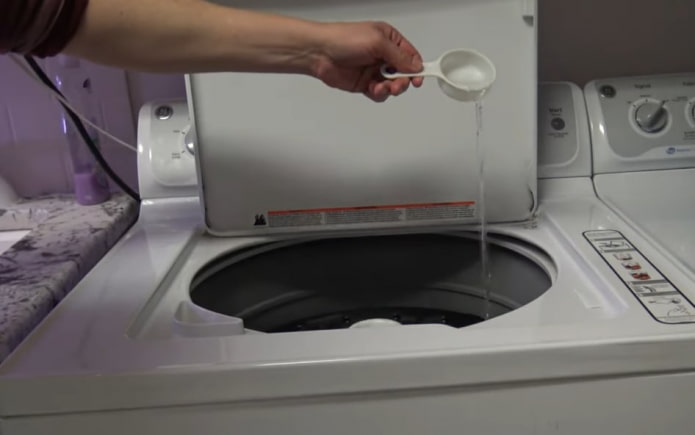
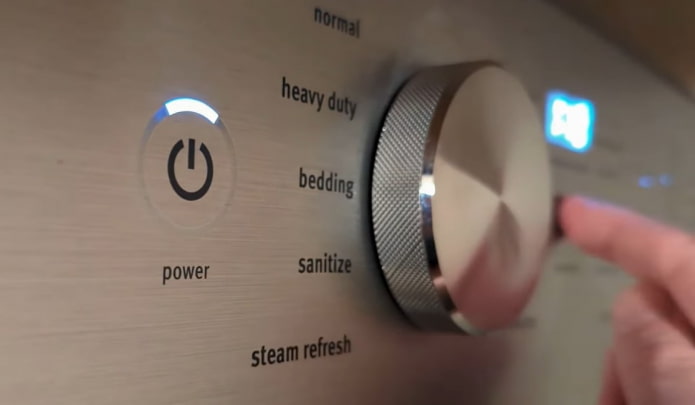
Drum cleaning products
When cleaning the drum, you can use different cleaning compounds depending on the type of contamination. The most popular products are:
- White vinegar. It is the most common product for cleaning the drum of a washing machine, as it perfectly removes salt deposits, produces a disinfectant effect, and eliminates unpleasant odors. At the same time, it remains safe for humans and the ecosystem. The only drawback is the characteristic pungent odor that remains after cleaning; however, it completely disappears after the first wash cycle using detergents (powders). For effective cleaning, 1 cup of the product is enough.
- Baking soda. It is one of the most effective means for removing dirt and mold. It is necessary to treat the affected areas with a soda solution and leave it for 60 minutes, then it can be washed off. It does not leave a smell and is relatively safe for humans.
- Citric acid. It is used as a means of combating scale: when interacting with carbonates, it forms soluble salts that are easily removed during cleaning. The use of citric acid is safe for humans and the environment.
- Copper sulfate. This is a substance that copes well with mold accumulations and has an antibacterial effect. As with baking soda, copper sulfate powder is dissolved in a small amount of water and rubbed onto the affected areas, then left for at least 1 hour and washed off (using a brush). The longer the substance interacts with the mold, the more effectively it destroys it.
Shop-bought detergents (powders and liquid compositions) are able to effectively remove various types of dirt.
- You can use universal cleaners (Beckmann, Frisch activ), which will quickly cope with most problems.
- As a last resort, resort to the help of bleach.
- There are also specialized compositions, for example, with an antibacterial effect (Sandokkaebi, Miele) or anti-scale (Magic Power, Top House, Luxus Professional).
It is important to use only those products intended for cleaning the washing machine.
Cleaning the drain
The drain hose ensures effective water drainage during washing, so it is necessary to monitor its condition continuously. If there are signs of blockage, the element needs to be cleaned. This is not difficult, because the hose is easily removed and it is easy to remove debris from it.
Step-by-step instructions:
- Disconnect the washing machine from the electrical network. Place it with the back side up and remove the protective cover (first unscrew the bolts).
- Unscrew the pump with the hose connected.
- Pull back the latch using a flange screwdriver.
- Then carefully twist the lower part (hose branch pipe) to the right and disconnect it from the upper part (pump).
- Remove debris from the drain hose. Try to clean deeper to completely remove dirt.
- Connect both parts (drain hose branch and pump), install in place.
- Screw the pump with the hose to the body.
- Install the protective panel (cover) and return the washing machine to its original position.
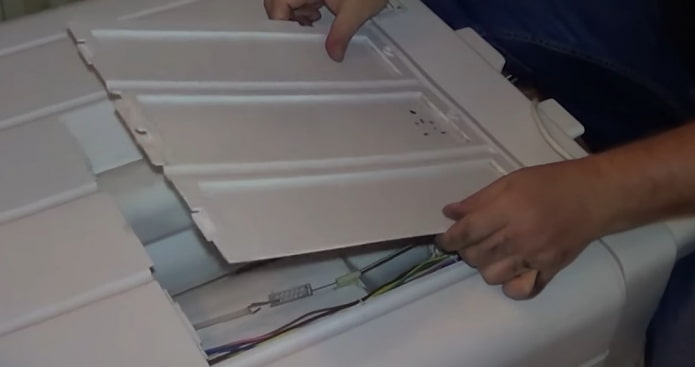
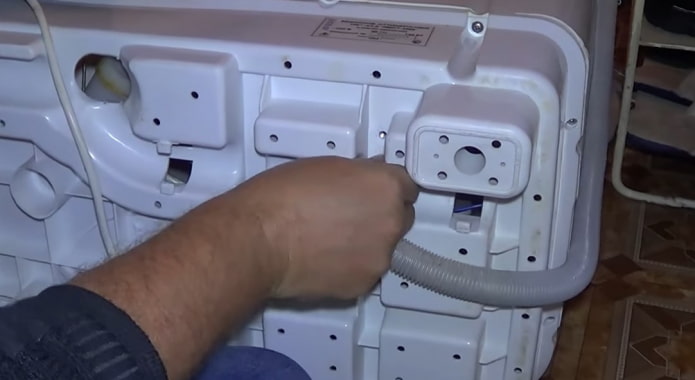
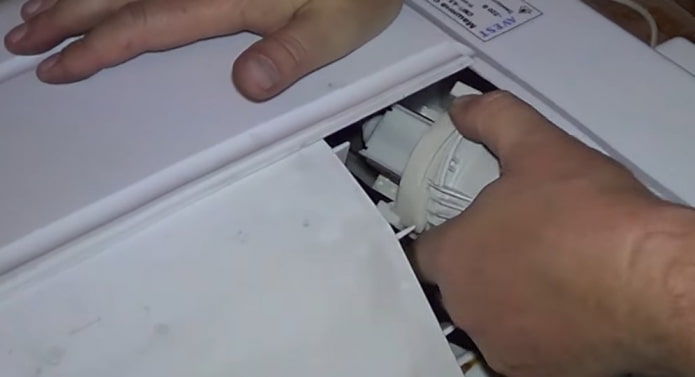
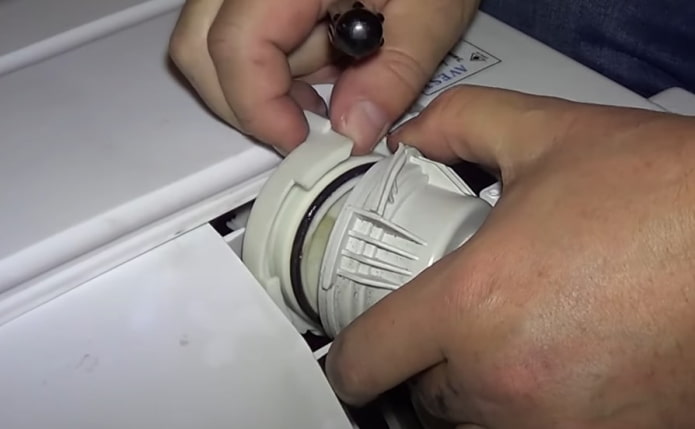
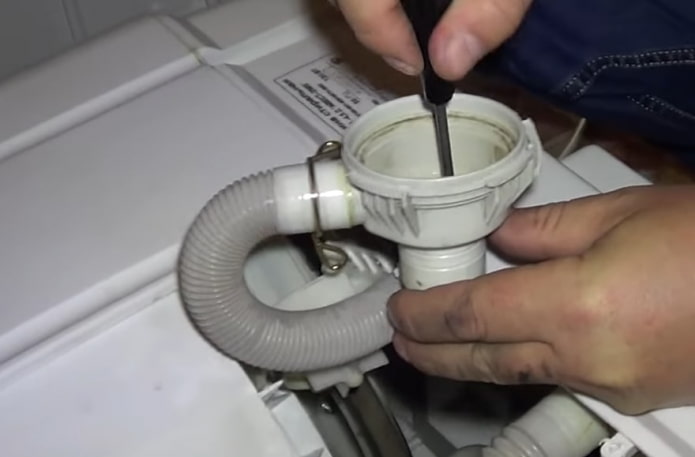
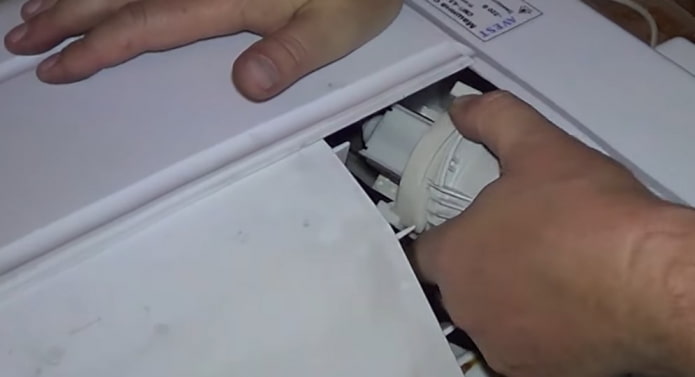
Cleaning the rubber
The rubber sealing cuff that encircles the opening (hatch) of the main tank is also susceptible to contamination. During washing, moisture and debris accumulate underneath it, which create a favorable environment for the growth of mold (mold fungi). Therefore, the rubber cuff also needs to be cleaned regularly.
Step-by-step instructions:
- Moisten a damp cloth with a small amount of dishwashing detergent. Start cleaning: generously rub the surface of the rubber seal (cuff), then bend it back and pour the composition inside the fold. Leave for 30 minutes.
- Close the door and start an empty wash cycle (without laundry or detergent), selecting the maximum temperature and time (also activate the rinse mode).
- When the wash is complete, open the door and rinse the cuff thoroughly. Leave the door open at room temperature until the drum and sealing rubber are completely dry.

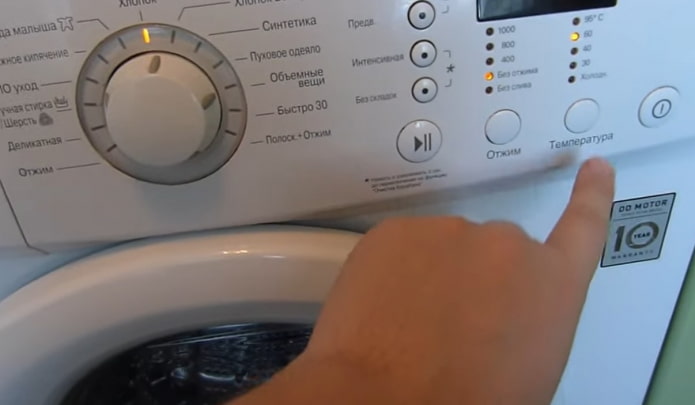
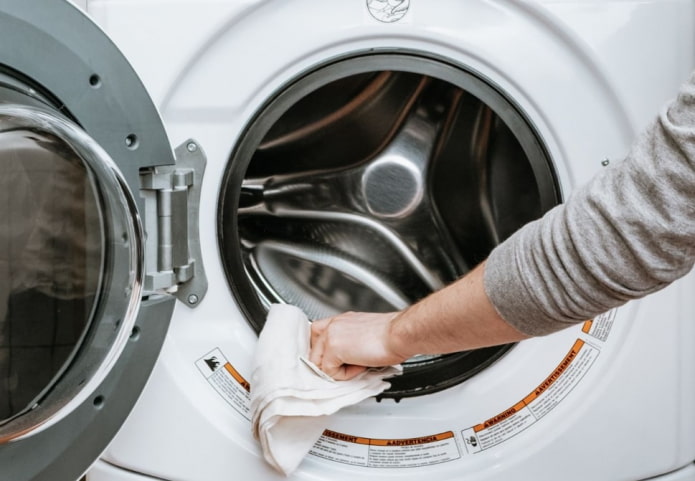
Wash the tray
Before getting into the main tank of the washing machine, the water passes through the tray compartment (where you need to pour in and pour in detergents. With each wash, powder and conditioner residues settle inside and outside the dispenser, and over time they form large accumulations, which leads to clogging. To prevent this, you need to remove the tray, thoroughly clean its surface and the walls of the connector.
Step-by-step instructions:
- Remove the detergent drawer from the slot. To do this, gently press the locking mechanism button, which is usually located inside or on the side of the structure.
- Place the drawer in the sink and begin mechanically cleaning the compartments. Use a stiff brush to thoroughly scrape off dried dirt. Remove the removable elements and wash them on all sides.
- Remove any remaining cleaning agents from the inside of the slot where the drawer is mounted. Use a plastic spatula or cloth for this purpose.
- Thoroughly clean the inner walls with a damp brush (or a stiff foam sponge). Small parts can be cleaned with a toothbrush.
- Dry the tray and put it back in place.
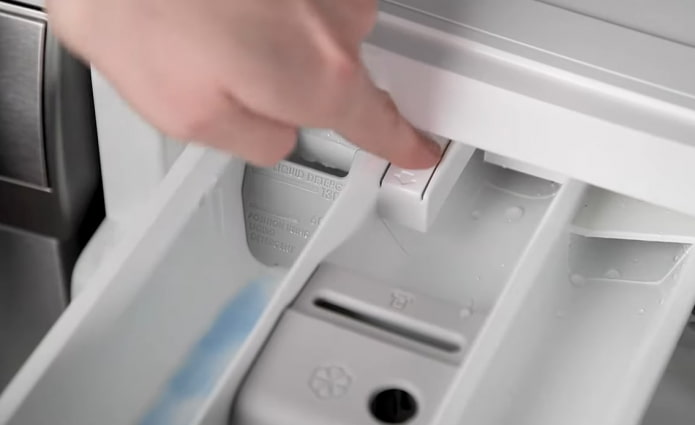
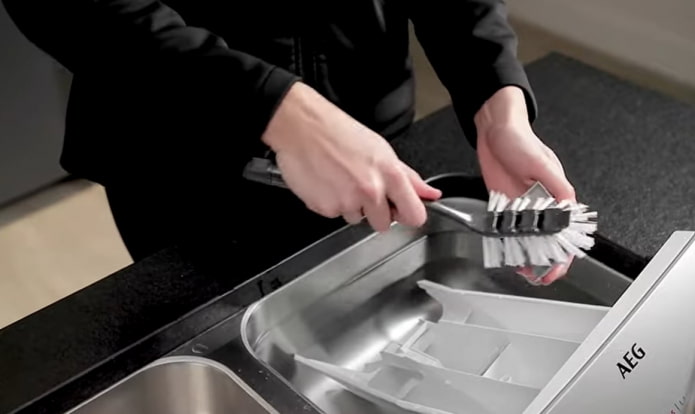
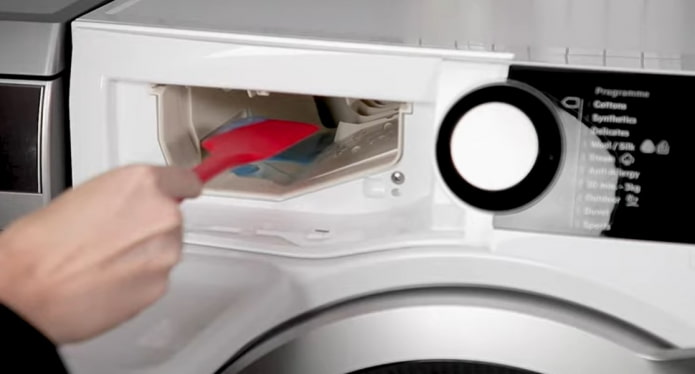
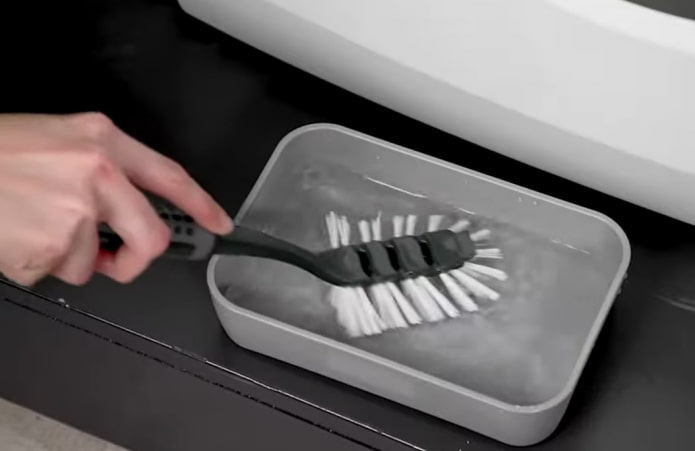
How to wash the drain filter
The filter is an important functional component of the washing machine, it traps small solid objects and prevents them from getting into the drain hose. Therefore, it must be cleaned periodically to avoid clogging, the development of pathogenic microflora and equipment breakdown.
Step-by-step instructions for cleaning the filter:
- Carefully remove the filter. It is usually located in the front lower part of the washing machine (on the right or left). Remove the outer protective panel, lay a moisture-absorbing cloth on the floor (or place a container or other container underneath). Unscrew the filter by rotating it counterclockwise. When you remove it, some water will flow out of the hole.
- Remove large contaminants from the filter. Then rinse thoroughly under running water. If dirt does not wash off or is located in hard-to-reach places, clean with a toothbrush.
- Replace the filter (insert into the hole and screw clockwise) and install the outer protective panel.
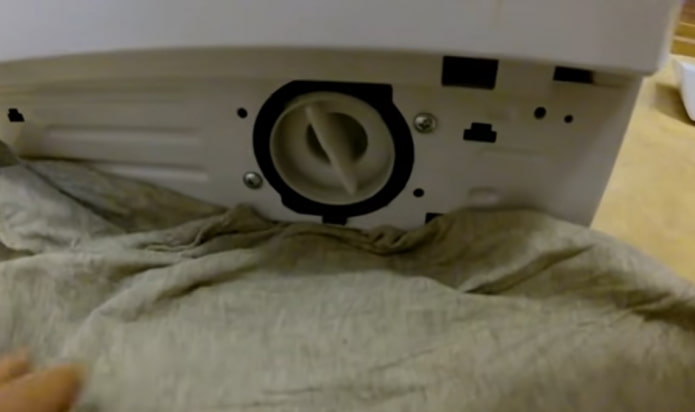
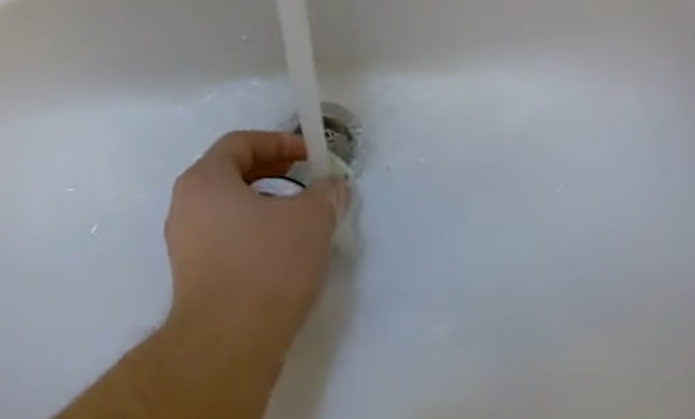
How and what to clean the heating element
The tubular electric heater (TEN) also needs regular cleaning, since limescale accumulates on it. This need arises much less often if specialized detergents for washing are used. Incorrect selection of compositions will accelerate wear of the component and significantly reduce its service life.
Step-by-step instructions:
- Carefully remove the heating element from the washing machine. First, disconnect the equipment from the power supply and drain the remaining water, then determine the location of the element (back or front). Remove the protective panel of the case, fasteners and take out the heater.
- Prepare the working solution: pour 2 liters of hot water into a plastic container and stir in 50 g of crystallized citric acid (replace with lemon juice if necessary).
- Immerse the part in the solution so that the heating element is completely hidden in the water. However, the terminals of the heating element (heating element) must remain dry, otherwise they will be damaged.
- Leave for 2-5 hours. We clean the heating element only after the layer of scale has started to come off easily (rub it with your hand in water to check).
- Remove the heating element from the solution and rinse under running warm water. Try to clean it completely, removing all scale residues.
- Dry the heating element and install the device in place.
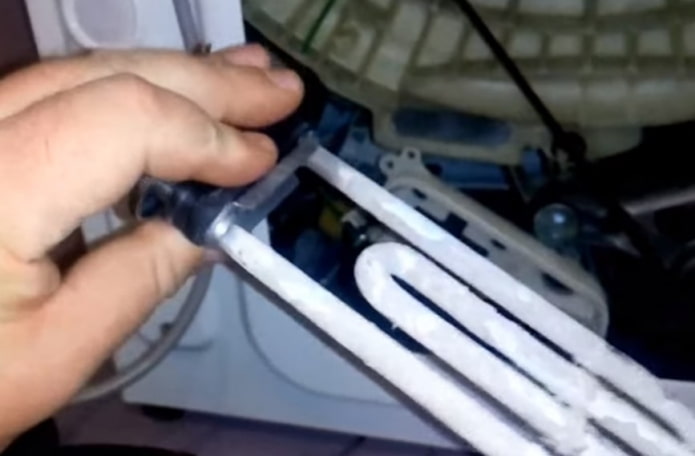
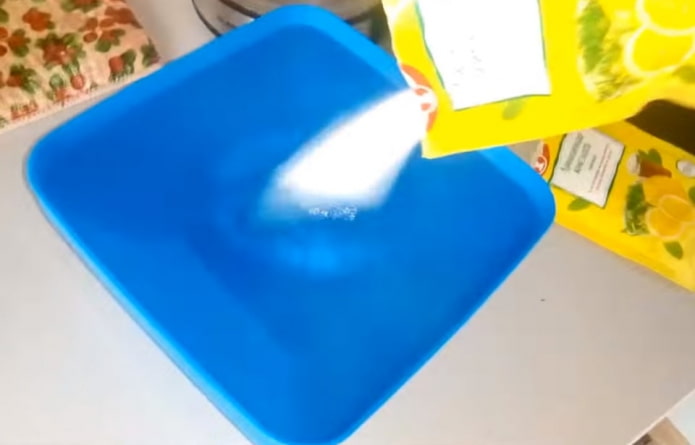
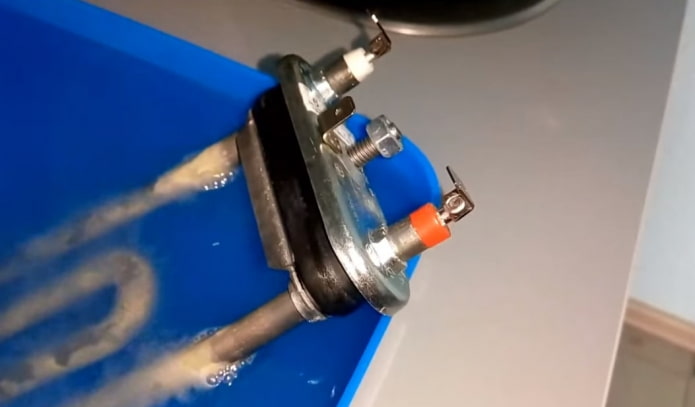
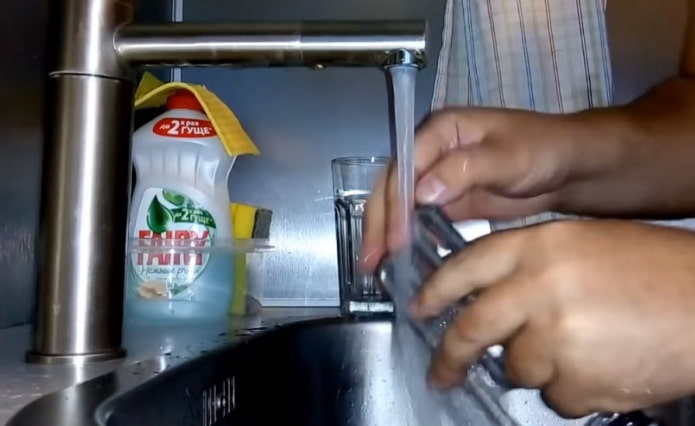
Compositions for cleaning the heating element
There are several folk remedies that can be used to effectively clean the electric heater (heating element) from limescale deposits. Of these, the most common are:
- Citric acid. This is a substance with medium-strength acidic properties that interacts with calcium and magnesium carbonates to form readily soluble salts (the process occurs faster at high temperatures). However, it is effective only if the dirt and scale deposits are thin. The working solution is prepared by dissolving citric acid crystals in hot (preferably boiling) water at a rate of 25 g of dry powder per 1 liter of liquid. Citric acid is safe for humans and animals.
- Vinegar. This is a weak acid, but it also reacts with carbonates, resulting in the formation of soluble calcium and magnesium acetates (salts). Allows you to remove thin scale deposits. The working solution is prepared by mixing a 9% vinegar solution and water at a rate of 50 ml of acid per 1 liter of liquid. When using this composition, you must use personal protective equipment (gloves).
- Orthophosphoric acid. This substance copes well with scale deposits, but is unsafe (belongs to hazard class II). It should be used in domestic conditions with great caution, after putting on protective equipment (gloves and a respirator). You will also need to limit the presence of children and animals in the room.
If the scale deposit is very thick, it is advisable to use professional cleaning products, including bleach, anti-scale agents, and special cleaners. They are expensive, but they do an excellent job of removing large accumulations of calcium and magnesium carbonates.
Prevention Recommendations
The best way to prevent heavy contamination, scale, and blockages is regular maintenance of the washing machine. It is necessary to clean the main components of the device monthly (or as they become dirty), including the drum, powder tray, drain filter and hose, cuff, and body. If you are not sure that you will be able to do the job well and completely remove scale and dirt, you will have to call an experienced technician.
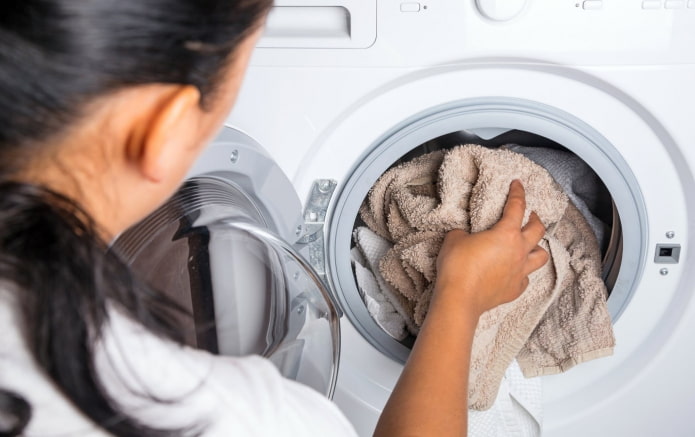
Also follow several important rules for operating and caring for the device:
- Do not overload the washing machine. Sort items (clothes and linens) by “related” characteristics, such as color, size, material.
- Use the optimal amount of detergent depending on the load volume. Using a large amount of liquid composition will lead to the deposition of chemicals on various components of the device.
- Use the correct detergent. For example, when using high-efficiency household appliances, it is prohibited to use the same type of compositions as in a conventional washing machine, since they produce too much foam. The wrong choice of composition will also lead to faster wear of the components of the unit.
- Do not leave wet laundry in the washing machine after loading things (clothes) or washing. High humidity and heat are favorable conditions for the development of mold fungi.
- After moving the laundry to the dryer, leave the door open so that the tank dries well. This prevents the development of mold.
- Use the steam mode (program), since high-temperature water vapor removes dirt well.
These rules for caring for the washing machine will help prevent scale formation and blockages, significantly extend the service life of the washing machine.
Now reading:
- Ideas for the home – creative solutions for interior, decor and storage
- Floating beds: more than 40 photos and ideas for bedroom, children’s and living room design.
- Half-timbered house: 40 unique photos and the best ideas for inspiration
- 10 stylish ideas for kitchen design in gray and white palette.
- Glossy or matte kitchen: 10 pros and cons for choosing.